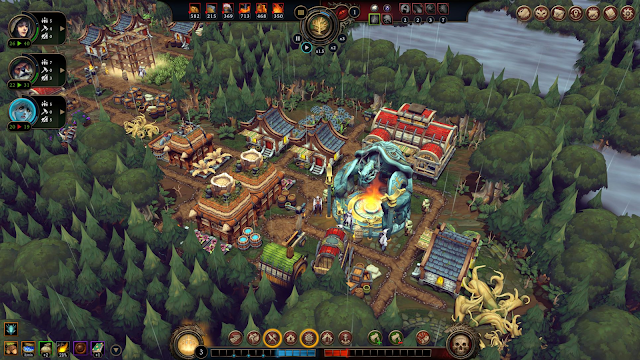Against the Storm by Eremite Games (Steam page, official site) is a popular 2.5D town-building run-based RTS with a Warcraft 3 inspired aesthetic and a deckbuilding meta-game progression.
Let's take a step back from all that roguelike deckbuilder packaging.
The core game design throughline is clear: they loved the Warcraft wood chopping mechanic, and so they made an entire game around it. And it really is a good mechanic. Chopping wood requires some some never-quite-fully-optimized worker placement, and earns you two crucial resources for more base building: lumber and land. Here they also borrow from Warcraft 3's level design language, specifically its "glades": little clearings in the forest with rewards if you cut a path to it and aggro them. But don't aggro them too early, chop wood in the right place at the right time, etc.
Then the designers had to figure out lumber sinks to consume all that wood. The main sink is burning wood to keep your town happy and warm, a page out of Frostpunk that also feels elegant here. But once you find a source of coal or wizard oil, wood is more for processing into advanced materials like planks to build a cooperage, which uses planks to make ale barrels, but you can brew ale only if you have enough wheat, etc.
The deckbuilder aspect means you have to improvise a tech tree out of the random building types you get dealt. For the first 5-10 hours it's fun enough to combo together supply chains and see all the funny little things you can make across a bunch of different bases. But after this I felt I had basically seen it all, and all my base building started feeling the same. Unfortunately games these days have to last 500 hours, so these crafting chains just keep spiraling in the hope that it can drive endless variation. There are now like 50+ possible building types, but like 30+ of them are just similar tier 2+ buildings that process a dozen raw resources into a dozen other crafted resources. It's a lot of deckbuilding oatmeal to eat.
The map types and randomized modifiers sometimes force you to play a bit differently, like "no crops" or "no meat." Unfortunately these random modifiers feel, um, random? An arbitrary constraint dropped on you, rather than an interesting evolving problem that requires you to really rethink everything.
This is perhaps my old school RTS bias showing, but I do wish they had handcrafted some actual levels with specific decks and different objectives for more meaningful cohesive variation. Handmade levels with varied objectives would've solved their biggest problem: a generic victory point endgame, where you fulfill random "orders" mini-goals like reaching a certain population size or selling 30 wood / 15 incense to get a victory point.
I think victory points work in board games because you're competing for them against other players, so it's a little sad and pointless to play Settlers of Catan by yourself like in this game. Yet even if they had made victory points feel more contested, I have to admit it would still feel disconnected from the core base building mechanic and economy.
I built an intricate complex city full of moving parts, and all I get are these imaginary number trophies? A more traditional design would've focused more on building wonders or clearing a map with a sense of tangible accomplishment, which also gets old after a while too, but at least it feels more real. This disconnected endgame feels like a core design hole that will require a very big scary change to truly solve, a problem that can't just be solved by adding yet another subsystem and menu panel, so I can't blame them for not wanting to tackle it. And if their audience is happy enough with it already, I guess it doesn't matter?
Industry-wise, what's most interesting about Against The Storm is their heavy investment in community engagement and frequent early access updates. They post an announcement every few days, and push a new content update every few weeks. They're using all the Steam community features that supposedly earns Valve their 30% cut! It seems extremely exhausting and likely requires multiple dedicated staffers, but maybe that's just the new normal of running a live service game today.
Against The Storm is available on Steam, and probably other platforms too, but it seems like everyone mostly plays it on Steam.



